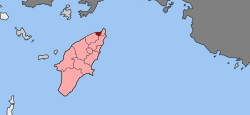Ialysos (Rhodes)
|
Parish of Ialysos Δημοτική Ενότητα Ιαλυσού (Ιαλυσός) |
||
|---|---|---|
|
|
||
| Basic data | ||
| State : |
|
|
| Region : |
South Aegean
|
|
| Regional District : | Rhodes | |
| Municipality : | Rhodes | |
| Geographic coordinates : | 36 ° 25 ′ N , 28 ° 9 ′ E | |
| Height above d. M .: | 0–267 m Aegean Sea– Filerimos |
|
| Area : | 16,700 km² | |
| Residents : | 11,331 (2011) | |
| Population density : | 678.5 inhabitants / km² | |
| Code No .: | 690105 | |
| Structure: |
1 municipality |
|
| Location in the municipality of Rhodes and in the regional district of Rhodes | ||
The municipality of Ialysos ( Greek Ιαλυσός ( m. Sg. )) Is named after the ancient city of Ialysos. In terms of area, Ialysos is the smallest municipality on the Greek island and municipality of Rhodes . The administrative center, now called Trianda, is the second largest city on the island after the city of Rhodes .
location
Ialysos is located on the coast of the Strait of Rhodes in the northeast of the island, west of Cape Zonari. Neighboring districts are the city of Rhodes in the east, Kallithea in the southeast and Petaloudes in the southwest and west.
mythology
According to legend, the three cities of Lindos , Ialyssos and Kamiros are said to have been founded by three brothers of the same name, who are descendants of the eldest of the Heliads , who in turn descended from Helios and his wife the nymph Rhode .
Rhodes took part in the war against Troy with nine ships under the leadership of Tlepolemos , Homer mentioning the three Rhodian places, Lindos, Ialyssos and Kameiros . This is also mentioned in Homer's ship catalog , among other things .
history
Numerous Minoan finds prove that Rhodes was already in the early 2nd millennium BC. Was settled by Cretans. The Minoan settlement of Ialysus counted in the 16th century BC. To the largest cities of the Aegean Sea . From approx. 1450 BC. BC Mycenaean Greeks took over power from the mainland not only on Crete, but also gradually in Cretan possessions, including Rhodes. According to the current state of research, the Minoan settlement existed well into the 14th century ( Late Minoan III A2 period), and until its end, the finds are strongly influenced by the Minoan. But even after that, Ialysus was probably of outstanding importance. Mario Benzi is of the opinion that it was - next to Miletus on the west coast of Asia Minor - the most important Mycenaean outpost in the eastern Aegean region . Excavations brought to light the largest and richest known Mycenaean necropolis in the Aegean world. This was already used by the inhabitants of the Minoan city. By contrast, only small remains of the associated Mycenaean settlement have been discovered so far. Large parts of it were probably destroyed by erosion or later overbuilding.
The island began to rise again in the 11th century BC. After the Dorians settled on Rhodes. They founded the three cities of Ialysos, Kameiros and Lindos , which ruled Rhodes as an independent poleis until they merged around 408 BC. BC to found the city of Rhodes on the northern tip of the island . The importance of the three cities was underscored not least by the fact that they were in the Hexapolis, the Doric six-city league, together with Kos , Knidos and Halicarnassus , the latter two located on the mainland of Asia Minor .
Filerimos
On the hill of Filerimos was the acropolis of the ancient city of Ialysus. In the excavation site, the foundations of an Athene Polias temple, a Doric fountain house, a cross-shaped baptismal font and floor mosaic of an early Christian basilica, partially overbuilt by a monastery and ruins from the Byzantine period, can be seen. In the cave church of Agios Georgios there are frescoes from the 15th century.
Web links
- Rhodesguide (English)
- Wissen.de history
Individual evidence
- ↑ Results of the 2011 census, Greek Statistical Office (ΕΛ.ΣΤΑΤ) ( Memento from June 27, 2015 in the Internet Archive ) (Excel document, 2.6 MB)
- ↑ According to conventional chronology; or 17th century, the early date of the Thera volcanic eruption would apply (see Minoan eruption )
- ↑ Luca Girella: Ialysus. Foreign relations in the Late Bronze Age. A funerary perspective , 129 online
- ↑ Mario Benzi: Anatolia and the eastern Aegaean at the time of the Trojan War , in: Omero tremila anni dopo: atti del Congresso di Genova, (6-8 luglio 2000), 2002, p. 375ff.
- ↑ ibid, p. 376

